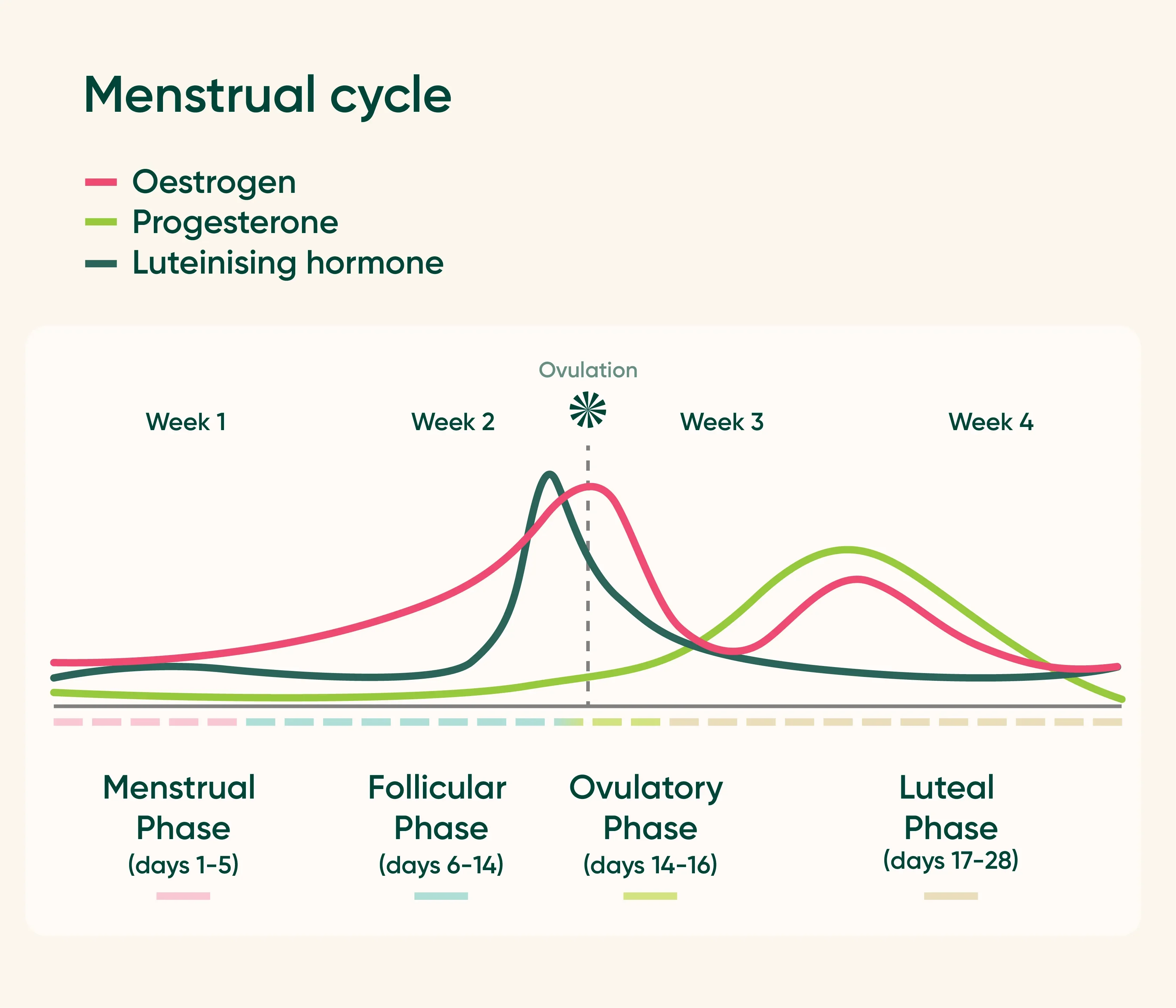Get in sync: the lowdown on women’s hormones

Hormones play a crucial role in how we feel and function, and their impact changes throughout our lives. From puberty to menopause, understanding these shifts can help us manage our physical and emotional health. We’re here to make understanding it as straightforward as possible, because when it comes to your health, knowledge really is power.
What are hormones?
Hormones are tiny molecules that act as messengers throughout the body. They are essential for life and for health because they tell your organs what to do and when to do it. There are at least 50 different hormones in the body that work across metabolism, digestion, blood sugar, blood pressure, growth, sexual function, mood and sleep.
For example:
- Melatonin helps regulate your sleep-wake cycle, ensuring you get a good night’s rest.
- Insulin manages blood sugar levels, playing a key role in how your body uses energy.
These are just two of the many hormones working tirelessly to keep you balanced.
The different types of hormones
The most significant changes in hormones during a woman's lifespan is seen with the sex hormones – the hormones that kick off menstruation (puberty) and shift as you move through child-bearing years, perimenopause, menopause and post-menopause. So, what are the key hormones for women to be aware of?
- Follicle-stimulating hormone (FSH): triggers the ovaries to produce follicles that contain immature eggs.
- Luteinising hormone (LH): helps the ovary release a mature egg into the uterus in preparation for conception (having a baby).
- Oestrogen is needed for fertility and pregnancy, overall menstrual cycle and its lesser known role in maintaining bone strength, healthy cholesterol levels and heart health.
- Progesterone is needed for thickening the uterine lining, prior to conception. Its key role is to create a healthy environment for the fertilised egg to implant. It also reduces inflammation, supports healthy thyroid function, contributes to breast health and has a calming effect within the brain.
Other key hormones include:
- Testosterone: yes, women have it too. It supports libido, bone health, muscle strength and mood.
- Cortisol: the stress response hormone, also affecting blood sugar and energy levels.
- Thyroid hormones: help control the body’s metabolism and also play a role in menstrual cycles.
Hormones through the life stages
Puberty (around age 10)
Puberty usually begins around the ages of 8 to 13 years and is a time when the body reaches reproductive maturity. The hormone oestrogen takes centre stage and this causes the uterus, breasts, ovaries and vagina to mature. These hormonal changes can also impact emotions and change how and where the body stores fat. Around 2 years after breast development starts, a woman will get her first period; this is called menstruation.
Menstruation (teenage years to 40s)
Menstruation becomes regular in the years following puberty and signifies the peak reproductive years between late teens and late thirties. A monthly cycle of rising and falling oestrogen and progesterone levels prepares the body for pregnancy. If no pregnancy occurs, the body will menstruate which involves discarding the monthly build up of tissue and blood from the uterus. This hormonal rollercoaster can influence mood, energy, and cravings.
Perimenopause (40s)
Perimenopause is the time when we transition into our period ending. It usually lasts between 4-6 years but can be shorter or longer. During this time, the body starts to run out of eggs, which causes our oestrogen and progesterone levels to drop. This then causes periods to become lighter or irregular and eventually leads to stopping a period entirely. During perimenopause women may experience hot flushes, mood swings, and have irregular cycles.
Menopause (around age 45 to 55)
This marks the end of a woman's reproductive years; menopause officially arrives after 12 months without a period. Oestrogen decreases, bringing symptoms like night sweats and mood changes.
Postmenopause (around age 45 to 55)
This stage officially begins after menopause. Hormonal stability may return but low oestrogen levels can increase the risk of heart disease and osteoporosis. It’s a time to prioritise bone and heart health.
How do hormonal changes affect women during menstruation?
Now that you know what’s going on with hormones, let’s take a closer look at the effects of hormonal changes during the menstrual cycle.
- During the follicular phase, as oestrogen increases and progesterone remains low, some may experience a better mood and feel energised and confident.
- Ovulation occurs around day 14; the few days before and after are known as the “fertile zone.”
- Then during the luteal phase, when oestrogen declines and progesterone rises, ‘PMS’ symptoms may rear their head. You might feel moody, tired, hungrier, or experience digestive upsets. In addition to this, some may also feel dull pain or cramping as bleeding begins.

What are the common symptoms of perimenopause?
Changes to your menstrual cycle can be one of the more obvious signs that perimenopause is taking place. Some women may also experience other symptoms such as:
- Hot flushes
- Mood changes, irritability and/or anxiety
- Difficulty concentrating
- Headaches or migraines
- Difficulty falling asleep, waking during the night, or poor sleep quality
- Fatigue
- Night sweats
- Changes in weight
- Breast tenderness
- Joint pain or aches
- Vaginal dryness
- Loss of sexual desire (libido)
How to get help with hormones
If you’re feeling out of sync, don’t suffer in silence. Here’s how you can get support:
- Blood tests may be able to identify hormonal imbalances or deficiencies. Talk to your healthcare professional about testing and a supplement if required.
- Nourish your body with a diet rich in whole foods and the five main food groups: Fruit, Vegetables & legumes, Grains, Dairy & Alternatives, Meat & Alternatives.
- Tailor your exercise to your life stage. Gentle exercise like yoga may be more beneficial during menstruation and resistance training can help to preserve muscle and bone mass in perimenopause and beyond. Talk to your healthcare professional about the best exercise for you.
Hormones are the unsung heroes of your body, shaping your life journey from puberty to postmenopause. While their shifts can feel overwhelming, understanding their role—and how to support them—can empower you to thrive at every stage. If your hormones feel out of tune, don’t hesitate to reach out for help. A balanced, healthy lifestyle and professional guidance can bring harmony back to your life.
Related articles:
Reviewed by Healthylife health experts January 2025.
This article is for informational purposes only and does not provide medical advice, diagnosis, or treatment. Any information published on this website or by this brand is not intended as a substitute for medical advice. If you have any concerns or questions about your health you should consult with a health professional.
